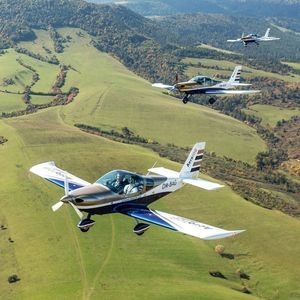
- Aircraft
- Aircraft
- Two-seater ULM aircraft
- Tomark Aero

- Products
- Catalogs
- News & Trends
- Exhibitions
Two-seater ULM aircraft Viper SD4 – NIGHT VFR4-stroke enginesingle-engine

Add to favorites
Compare this product
Characteristics
- Number of seats
- two-seater
- Motorization
- 4-stroke engine
- Other characteristics
- single-engine
- Length
6.44 m
(21'01" )- Height
2.27 m
(7'05" )- Wingspan
8.34 m
(27'04" )- Max. take-off weight
600 kg
(1,323 lb)- Fuel capacity
100 l
(26.4 gal)- Fuel consumption
14.5 l/h
(3.8 us gal/h)- Range
1,350 km
(839 mi)- Cruise speed
190 km/h
(118 mph)- Stall speed
91 km/h
(57 mph)- Rate of climb
5 m/s
(16 ft/s)- Take-off distance required
420 m
(1377'11" )- Landing distance required
450 m
(1476'04" )
Description
Viper SD4 RTC certified by EASA for the CS-LSA category with a supplemented model for night flying. The Viper SD4 Night-VFR meets the requirements for VFR night flying and allows you to fly according to VFR NIGHT flight rules. The aircraft complies with SC-OLSA-div-01: Special Terms for VFR night operations for LSA airplanes. This means flying at night under VFR (Visual Flight Rules) conditions.
EASA CERTIFIED
certified and eligible aircraft for Night-VFR flights, night flight operations
GREAT FOR PILOT TRAINING
obtain a VFR NIGHT rating and teach a pilot to fly according to the rules for VFR NIGHT FLIGHTS
SUCCESSFULLY SPIN TESTS
Carrying out the corkscrew tests necessary to obtain the EASA CS-LSA certificate
Avionic equipment
Modern Dynon SkyView 10” digital instruments on both sides of the dashboard ensure the clear display of flight and engine indicators. Flight data display is duplicated thanks to certified analog instruments – speedometer, altimeter and compass. The ELT safety transmitter is part of the left panel. Modern communication devices, navigation radio (NAV/COM) and transponder allow seamless communication of the crew with the surroundings. An important part of the equipment is a certified artificial horizon located in the middle part. The instrument panel is characterized by ergonomically positioned and clearly arranged avionic equipment and trouble-free operation of all instruments. With an emphasis on safety and simplicity while maintaining the highest possible level of comfort.
Flying beyond the horizon
Night flying and Night-VFR qualifications are very interesting and important for several reasons.
VIDEO
*Prices are pre-tax. They exclude delivery charges and customs duties and do not include additional charges for installation or activation options. Prices are indicative only and may vary by country, with changes to the cost of raw materials and exchange rates.




